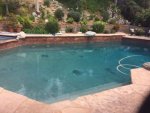Hello to everyone,

The black stains in the picture started coming 4 years after we moved in in 2001.
No one knew what they were and I made everything worse by putting 3" tablets on them, dry acid in a sock, etc.
Finally decided to get it re-plastered. 40,000 psi hydrojet to remove plaster.
When hitting stains with hydrojet some voids opened up around an abandoned in-ground cleaner system.
Bad patch job?, ground water?, don't really know.
Haven't found all pipes but some areas that had a stain I see some rebar where the hydrojet exposed it. Pool re-plaster guy believes the stains are from the rebar.
Wants to fill all areas with hydro-static cement.
Also what I thought were 2 main drains for 18 years, one has a hydrostatic plug and the other one looks like it's full of original plaster.
After looking up in-floor systems I thought a main drain was originally needed?
Hope some of this makes sense.
Please, looking for some opinions, ideas, anything on what to do.
Thanks


The black stains in the picture started coming 4 years after we moved in in 2001.
No one knew what they were and I made everything worse by putting 3" tablets on them, dry acid in a sock, etc.
Finally decided to get it re-plastered. 40,000 psi hydrojet to remove plaster.
When hitting stains with hydrojet some voids opened up around an abandoned in-ground cleaner system.
Bad patch job?, ground water?, don't really know.
Haven't found all pipes but some areas that had a stain I see some rebar where the hydrojet exposed it. Pool re-plaster guy believes the stains are from the rebar.
Wants to fill all areas with hydro-static cement.
Also what I thought were 2 main drains for 18 years, one has a hydrostatic plug and the other one looks like it's full of original plaster.
After looking up in-floor systems I thought a main drain was originally needed?
Hope some of this makes sense.
Please, looking for some opinions, ideas, anything on what to do.
Thanks




